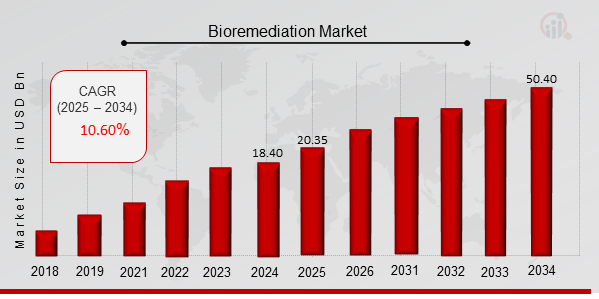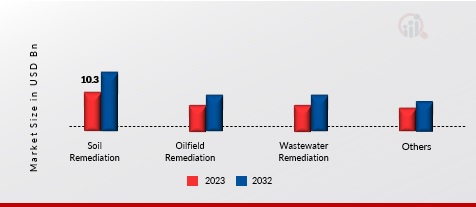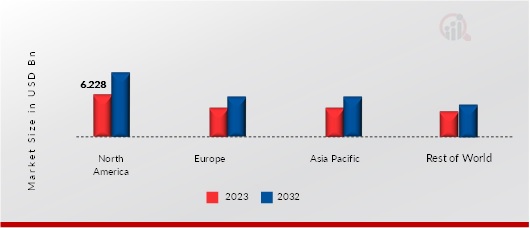Bioremediation Market Overview
As per MRFR analysis, the Bioremediation Market Size was estimated at 18.40 (USD Billion) in 2024. The Bioremediation Market Industry is expected to grow from 20.35 (USD Billion) in 2025 to 50.40 (USD Billion) till 2034, at a CAGR (growth rate) is expected to be around 10.60% during the forecast period (2025 - 2034). Increasing awareness and concern about environmental pollution and its impact on human health and ecosystemsare the primary market drivers for improving market growth.

Source: The Primary Research, Secondary Research, MRFR Database and Analyst Review
Bioremediation Market Trends
-
The growing adoption of sustainable environmental solutions is driving the market growth.
Market CAGR for bioremediation is being driven by the increasing adoption of sustainable environmental solutions. As global concerns about environmental degradation and pollution intensify, governments, industries, and communities are actively seeking strategies to mitigate their environmental footprint while ensuring sustainable development. In this context, bioremediation emerges as a compelling solution due to its inherent eco-friendly nature and effectiveness in addressing pollution challenges.
Governments worldwide are implementing stringent environmental regulations to safeguard ecosystems, public health, and natural resources. These regulations often mandate the cleanup of contaminated sites and the responsible management of hazardous waste. Bioremediation offers an environmentally sound approach to meet these regulatory obligations, as it utilizes naturally occurring microorganisms or plants to degrade or neutralize pollutants without causing additional harm to the environment. Consequently, industries facing regulatory scrutiny increasingly turn to bioremediation technologies to achieve compliance while minimizing their environmental impact. Moreover, the growing awareness and demand for sustainability among consumers and stakeholders play a crucial role in driving the adoption of bioremediation solutions. Businesses are under mounting pressure to demonstrate their commitment to environmental stewardship and corporate social responsibility. As a result, they are actively seeking environmentally friendly alternatives to conventional remediation methods, such as chemical treatments or incineration, which can be energy-intensive and generate harmful byproducts. Bioremediation offers a more sustainable alternative, aligning with the values and expectations of environmentally conscious consumers and investors. This growing demand for sustainable practices incentivizes businesses to invest in bioremediation technologies, thereby expanding the market.
Technological advancements and innovation also contribute significantly to the growth of the bioremediation market in the context of increasing adoption of sustainable environmental solutions. Researchers and companies are continually developing and refining bioremediation techniques, leveraging advancements in biotechnology, genomics, and microbial ecology. These innovations enhance the efficiency, scalability, and applicability of bioremediation processes, enabling them to address a broader range of contaminants and environmental conditions. Additionally, ongoing research efforts focus on optimizing microbial consortia and engineering specialized enzymes to enhance pollutant degradation rates and improve remediation outcomes. As a result, the expanding capabilities and versatility of bioremediation technologies further stimulate market growth, driving adoption across diverse industries and environmental contexts. The advancements in biotechnology and genetic engineering techniques enable the development of more efficient and specialized microbial strains that can degrade a wider range of pollutants and thrive in diverse environmental conditions. By harnessing these cutting-edge biotechnologies, bioremediation companies can offer more effective and tailored solutions for cleaning up contaminated sites, accelerating the remediation process, and expanding the applicability of bioremediation to new types of pollutants and environments.Thus driving the Bioremediation market revenue.
Bioremediation Market Segment Insights
Bioremediation Type Insights
The Bioremediation Market segmentation, based on type, includes . In 2023, the in-situ segment dominated the market . Hence, it is highly suited for applications like the treatment of groundwater with low contaminant concentration, where the availability of oxygen can be raised by pumping air into the soil subsurface. Further, the ex-situ technique is broadly used for the treatment of contaminated soil and the removal of hydrocarbons.
Bioremediation Technology Insights
The Bioremediation Market segmentation, based on technology, includes In 2023, the phytoremediation category dominated the market . Moreover, the technique has comparatively low costs than other technologies and has the ability to sustainably remove inorganic and organic pollutants from water and soil. Furthermore, fungal remediation is anticipated to be the fastest growing as fungi can demonstrate a broad range of metabolic capacities and can withstand high concentrations of polluting agents.
Bioremediation Service Insights
The Bioremediation Market segmentation, based on service, includesIn 2023, the soil remediation category dominated the segment . The service includes the removal of soil contaminants emerging from sources, like improper waste disposal, dumping of chemicals, pipe leaks & spills, and others. Further, oilfield remediation is foreseen to grow at the fastest rate owing to the fast expansion of the crude oil industry and the development of eco-friendly oilfield remediation options.
Figure 1: Bioremediation Market, by Service, 2023 & 2032 (USD Billion)

Source: The Primary Research, Secondary Research, MRFR Database and Analyst Review
Bioremediation Regional Insights
By region, the study gives market insights into North America, Europe, Asia-Pacific, and the Rest of the World. The North American Bioremediation market area dominates this market due to the presence of high industrial growth & waste production, sophisticated infrastructure, and availability of key market players. Additionally, the region has substantial research potential for bioremediation, driving the advancements in technology and boosting market growth.
Further, the primary countries studied in the market report are the US, Canada, Germany, France, the UK, Italy, Spain, China, India, Japan, Australia, and South Korea.
Figure 2: Bioremediation Market Share By Region 2023 (USD Billion)

Source: The Primary Research, Secondary Research, MRFR Database and Analyst Review
Europe's Bioremediation market accounts for the second-largest market share due to the stringent environmental regulations and growing public awareness regarding environmental sustainability. Further, the German Bioremediation market held the largest market share, and the UK Bioremediation market was the fastest-growing market in the European region.
The Asia-Pacific Bioremediation Market is expected to grow at the fastest CAGR from 2025 to 2034. This is due to the production of large amounts of hazardous waste owing to the growing economic development and increasing awareness about environmental protection in this region. Moreover, China’s Bioremediation market held the largest market share, and the Indian Bioremediation market was the fastest growing market in the Asia-Pacific region.
Bioremediation Key Market Players & Competitive Insights
Leading market participants are investing heavily in the research and development in order to expand their product lines, which will help the Bioremediation market grow even more. Market players are also undertaking different strategic activities to spread their global footprint, with important market developments including new product launches, higher investments, contractual agreements, mergers and acquisitions, and collaboration with other organizations. To expand and sustain itself in a more competitive and advancing market climate, the bioremediation industry must offer cost-effective items.
Manufacturing locally to minimize operational costs is one of the primary business tactics used by manufacturers in the global Bioremediation industry to benefit clients and increase the market sector. In recent years, the Bioremediation industry has offered some of the most significant advantages to the environment. Major players in the Bioremediation market, including and others, are trying to raise market demand by investing in the research and development operations.
Newterra Inc. is a Canadian-based company that specializes in water treatment solutions for various industries, including industrial, municipal, and environmental sectors. They provide innovative and sustainable water treatment technologies and services to address challenges related to water purification, wastewater treatment, and groundwater remediation. Newterra's solutions often incorporate advanced technologies such as membrane filtration, biological treatment, and modular systems designed for efficient and cost-effective water management. The company is known for its focus on environmental stewardship and its commitment to delivering reliable and customized water treatment solutions to clients worldwide. In October 2022, H2O Engineering Inc. was acquired by Newterra Inc.; this will help Newterra to broaden its reach into other segments like controlled environment agriculture, remediation, light industrial, and beverage sectors when improving its service delivery, manufacturing base, and engineering design based on the West Coast.
Allonnia is a bio-ingenuity company, abiotechnology company based in Boston, Massachusetts, focusing on using natural organisms to solve environmental problems. They use microbes and other biological processes to address challenges like sustainable mining, reducing pollutants, and even upcycling plastics. They consider themselves a bio-ingenuity company and believe that nature holds the key to solving some of the world's toughest waste problems. Their goal is to create a future where nothing goes to waste. In March 2021, Allonnia gained an investment worth 20 million USD in order to strengthen its bioremediation portfolio for oil sand-related pollutants. This broadened the company's offering and enhanced its market presence.
Key Companies in the Bioremediation market include
- Newterra Ltd.
- Sumas Remediation Service Inc.
- Probiosphere, Inc.
- Drylet, Inc.
- Xylem, Inc
- Regenesis Corporation
- Aquatech International Corp.
- Envirogen Technologies, Inc.
- MicroGen Biotech Ltd.
- Oil Spill Eater International Inc
Bioremediation Industry Developments
February 2022: In the US, the America COMPETES Act of 2022 was passed and was set to undertake the National engineering Biology Research & Development Initiative, for offering funding opportunities for bioremediation and related bioengineering solutions.
Bioremediation Market Segmentation
Bioremediation Type Outlook
Bioremediation Technology Outlook
- Biostimulation
- Phytoremediation
- Bioreactors
- Fungal Remediation
- Bioaugmentation
- Land-Based Treatment
Bioremediation Service Outlook
- Soil Remediation
- Oilfield Remediation
- Wastewater Remediation
- Others
Bioremediation Regional Outlook
North America
- Germany
- France
- UK
- Italy
- Spain
- Rest of Europe
Asia-Pacific
- China
- Japan
- India
- South Korea
- Australia
- Rest of Asia-Pacific
Rest of the World
-
Middle East
-
Africa
-
Latin America
| Report Attribute/Metric |
Details |
|
Market Size 2024
|
18.40 (USD Billion)
|
|
Market Size 2025
|
20.35 (USD Billion)
|
|
Market Size 2034
|
50.40 (USD Billion)
|
|
Compound Annual Growth Rate (CAGR)
|
10.60 % (2025 - 2034)
|
|
Report Coverage
|
Revenue Forecast, Competitive Landscape, Growth Factors, and Trends
|
|
Base Year
|
2024
|
|
Market Forecast Period
|
2025 - 2034
|
|
Historical Data
|
2020 - 2024
|
| Report Coverage |
Revenue Forecast, The Market Competitive Landscape, Growth Factors, and Trends |
| Segments Covered |
Type, Technology, Service, and Region |
| Geographies Covered |
North America, Europe, Asia Pacific, and the Rest of the World |
| Countries Covered |
The US, Canada, Germany, France, UK, Italy, Spain, China, India, Japan, Australia, South Korea |
| Key Companies Profiled |
Newterra Ltd.; Drylet, Inc.; Sumas Remediation Service Inc.; Probiosphere, Inc.; Xylem, Inc; Regenesis Corporation; Envirogen Technologies, Inc.; Aquatech International Corp.; MicroGen Biotech Ltd.; Oil Spill Eater International Inc |
| Key Market Opportunities |
· Integration of developing technologies like machine learning and AI to optimize and automate the monitoring and management of the bioremediation process. |
| Key Market Dynamics |
· Rapid industrialization and population growth in developing countries. |
Frequently Asked Questions (FAQ) :
The Bioremediation Market size was valued at USD 15.041 Billion in 2023.
The global market is foreseen to rise at a CAGR of 10.60% during the forecast period, 2025-2034.
North America held the largest revenue share of the global market.
The key players in the market are Newterra Ltd., Sumas Remediation Service Inc., Probiosphere, Inc., Drylet, Inc., Xylem, Inc., Regenesis Corporation, Aquatech International Corp., Envirogen Technologies, Inc., MicroGen Biotech Ltd., Oil Spill Eater International Inc., and others.
The in-situ category dominated the market in 2023.
Phytoremediation had the largest share in the global market.

















